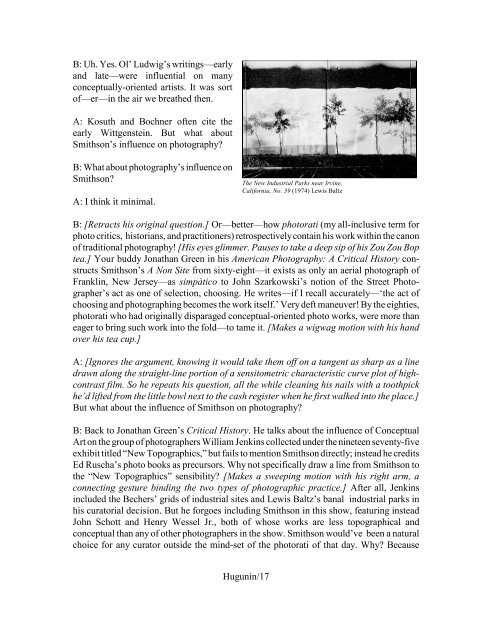It's Art, But Is It Photography? Robert Smithson's - Uturn.org
It's Art, But Is It Photography? Robert Smithson's - Uturn.org
It's Art, But Is It Photography? Robert Smithson's - Uturn.org
You also want an ePaper? Increase the reach of your titles
YUMPU automatically turns print PDFs into web optimized ePapers that Google loves.
B: Uh. Yes. Ol’ Ludwig’s writings—early<br />
and late—were influential on many<br />
conceptually-oriented artists. <strong>It</strong> was sort<br />
of—er—in the air we breathed then.<br />
A: Kosuth and Bochner often cite the<br />
early Wittgenstein. <strong>But</strong> what about<br />
Smithson’s influence on photography?<br />
B: What about photography’s influence on<br />
Smithson?<br />
A: I think it minimal.<br />
The New Industrial Parks near Irvine,<br />
California, No. 39 (1974) Lewis Baltz<br />
B: [Retracts his original question.] Or—better—how photorati (my all-inclusive term for<br />
photo critics, historians, and practitioners) retrospectively contain his work within the canon<br />
of traditional photography! [His eyes glimmer. Pauses to take a deep sip of his Zou Zou Bop<br />
tea.] Your buddy Jonathan Green in his American <strong>Photography</strong>: A Critical History constructs<br />
Smithson’s A Non Site from sixty-eight—it exists as only an aerial photograph of<br />
Franklin, New Jersey—as simpàtico to John Szarkowski’s notion of the Street Photographer’s<br />
act as one of selection, choosing. He writes—if I recall accurately—‘the act of<br />
choosing and photographing becomes the work itself.’ Very deft maneuver! By the eighties,<br />
photorati who had originally disparaged conceptual-oriented photo works, were more than<br />
eager to bring such work into the fold—to tame it. [Makes a wigwag motion with his hand<br />
over his tea cup.]<br />
A: [Ignores the argument, knowing it would take them off on a tangent as sharp as a line<br />
drawn along the straight-line portion of a sensitometric characteristic curve plot of highcontrast<br />
film. So he repeats his question, all the while cleaning his nails with a toothpick<br />
he’d lifted from the little bowl next to the cash register when he first walked into the place.]<br />
<strong>But</strong> what about the influence of Smithson on photography?<br />
B: Back to Jonathan Green’s Critical History. He talks about the influence of Conceptual<br />
<strong>Art</strong> on the group of photographers William Jenkins collected under the nineteen seventy-five<br />
exhibit titled “New Topographics,” but fails to mention Smithson directly; instead he credits<br />
Ed Ruscha’s photo books as precursors. Why not specifically draw a line from Smithson to<br />
the “New Topographics” sensibility? [Makes a sweeping motion with his right arm, a<br />
connecting gesture binding the two types of photographic practice.] After all, Jenkins<br />
included the Bechers’ grids of industrial sites and Lewis Baltz’s banal industrial parks in<br />
his curatorial decision. <strong>But</strong> he f<strong>org</strong>oes including Smithson in this show, featuring instead<br />
John Schott and Henry Wessel Jr., both of whose works are less topographical and<br />
conceptual than any of other photographers in the show. Smithson would’ve been a natural<br />
choice for any curator outside the mind-set of the photorati of that day. Why? Because<br />
Hugunin/17


